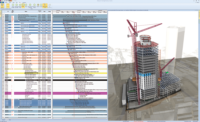Moore says safety now plays a larger role in planning before the project goes to field. He says it is surprising how a safety manager can view a 4D construction plan in a totally different way than the rest of the team.
"They are instantly visualizing the required fall protection, dropped-object hazards, eye-wash station locations, etc.," Moore says. "We now get detailed and substantive feedback from our safety department during early construction planning, which shapes the way that we approach our projects."
On one recent powerplant project on which TIC used Synchro for 4D modeling, Moore says "the 4D model made it clear that our scheduled plan was not factoring in safety."
Activities were being scheduled literally on top of others, he notes. When corrections were made the project ended up taking much longer than originally planned.
"If these 4D safety observations had been fed back into the schedule from the beginning we would have had a much greater grasp of the sequence and duration of this work," Moore says. "With 4D, we can now catch these issues in our schedules years ahead of their occurrence, allowing us to create better and more realistic plans from the beginning."
Jay Mezher, director for virtual design and construction at Parsons Brinckerhoff, says leveraging 4D BIM for safety follows an innovation trail he has seen with the use of computational fluid dynamics for modeling ventilation in tunnels, and evacuation modeling.
Widening Use
Doug Rowe, general manager of builder Lend Lease's integrated project group, says the company routinely uses 4D BIM to model and simulate detailed safety and logistics plans during risk analysis throughout projects.
He predicts that as the technology becomes more user-friendly, 4D BIM for detailed installation simulations will become more common "and will clearly drive safer and more productive workflows on all construction projects over the coming years."
McCarthy's McBroom says better 4D planning not only makes jobs safer but also communicates planned activities better to all stakeholders in a project, including the owners and the public.
"Planning on the fly is the same as not having a plan," he says. "That's just reacting. When you are trying to plan on the fly … that's usually when something goes wrong."
McBroom says one scenario in which he intends to use 4D modeling to enhance safety is during mixed-skin construction on multi-story buildings.
The company just finished one such project. It tracked the day-to-day work locations on the face of the building of construction trades workers doing masonry, framing, panel installation and glazing with color markers on isometric 2D plans day after day.
He said he realized as they wrapped up the project that modeling those locations using 4D would help ensure that no activity violated one of McCarthy's fundamental safety rules, which is that if crews are working overhead, nobody is underneath.
"The application of 4D to that is perfect. I don't have to look at a CPM schedule and try to imagine where every crew is; I can look at the [4D] representation of the model at any point in time and see what crew is working on what level. That would be a great application of 4D and safety," McBroom says.
Safety, Translated
Experts say visualizations can be very effective for communicating life-safety information—especially to non-English speaking workers.
Ricardo Khan, director of integrated construction at Mortenson Construction, is working with Caroline Clevenger, an assistant professor at Colorado State University, to draw site- and task-specific bilingual visual training tools directly from 4D models of planned activities.
They are starting with scaffold erection, with its significant fall hazards, and are visually drilling into the activities to train novice and non-English speaking construction workers, whose injury rates far exceed other categories.
Clevenger notes also that Hispanic construction workers are twice as likely to be injured on the jobsite as non-Hispanic workers. She says research suggests the higher injury rate is due, in part, to language and cultural barriers on site.
"I would like to see future efforts of 4D modeling begin to focus on a micro level," says Ryan Poropat, a Mortenson superintendent who recently used 4D tools on a sports and entertainment center in Buffalo, N.Y.
Their efforts are in line with another 4D BIM- related mission of Jason Reece, a Balfour Beatty research and development leader based in Fairfax, Va. He has studied the industry's long-running failure to communicate critical safety knowledge about construction risks, such as trenching.
Like Clevenger and Kahn, Reece sees an opportunity to improve training through BIM-enabled visual storytelling, which, combined with personal stories about real incidents, can help create "the written, audio and visual hooks that make information stick," he says.
Creating realistic visualizations of high-risk scenarios in the context of the work, and then showing how hazards should be mitigated, is a powerful way to leverage technology for safety, Reece says. He suggests that if safety trainers take advantage of BIM and visualization to improve safety-related storytelling, their training will have more effect.
"Create the mental hooks for the information; that's how people remember and how you are going to change safety culture," Reece says.
Stories are information. "If you want to use BIM for safety you have to learn what makes a good story and what makes ideas stick."












